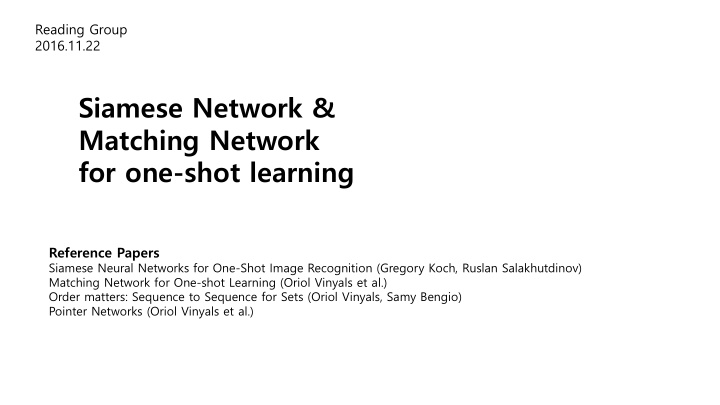



Reading Group 2016.11.22 Siamese Network & Matching Network for one-shot learning Reference Papers Siamese Neural Networks for One-Shot Image Recognition (Gregory Koch, Ruslan Salakhutdinov) Matching Network for One-shot Learning (Oriol Vinyals et al.) Order matters: Sequence to Sequence for Sets (Oriol Vinyals, Samy Bengio) Pointer Networks (Oriol Vinyals et al.)
Face verification - Verify whether a given test image is in the same class - Large number of classes of data - Number of training samples for a target class is very small [ Solution ] Learning a similarity metric from data and then used it for target class Learning a Similarity Metric Discriminatively, with Application to Face Verification (Sumit Chopra, Yann LeCun, 2005)
Verification to One-shot task Siamese Neural Networks for One-Shot Image Recognition (Gregory Koch, Ruslan Salakhutdinov, 2016)
Siamese Network Energy function Optimization One-shot classification Siamese Neural Networks for One-Shot Image Recognition (Gregory Koch, Ruslan Salakhutdinov, 2016)
Experiments Siamese Neural Networks for One-Shot Image Recognition (Gregory Koch, Ruslan Salakhutdinov, 2016)
Matching Network One(few)–shot prediction " : test data 𝑦 𝑦 # : support set f: input data embedding function g: support set embedding function c : cosine similarity Key idea : context embedding for one(few)-shot sets Matching Network for One-shot Learning (Oriol Vinyals et al., NIPS 2016)
Training objective Objective : maximize the conditional probability given data and support set T : full task set L : label set S : support set (one or few-shot set) B : training batch Matching Network for One-shot Learning (Oriol Vinyals et al., NIPS 2016)
Context Embedding Embedding for f (input data) : Attention LSTM Embedding for g (support set) : Bidirectional LSTM Matching Network for One-shot Learning (Oriol Vinyals et al., NIPS 2016)
Sequence-to-sequence model : a pair of an input and its corresponding target Sequence-to-sequence paradigm both X and Y are represented by sequences, of possibly different lengths: [ref] Sequence to Sequence Learning with Neural Networks (Ilya Sutskever, Oriol Vinyals, NIPS 2014)
Sequence-to-sequence model Decoder Encoder What if input does not naturally correspond to a sequence ? [ref] Sequence to Sequence Learning with Neural Networks (Ilya Sutskever, Oriol Vinyals, NIPS 2014)
Order matters - Altering the order of sequence in the context of machine translation : performance changes - English to French ; reversing the order of input sentence Sutskever et a. (2014) got 5.0 BLEU score improvement - Constituency parsing ; reversing the order of input sentence 0.5% increase in F1 score (Vinyals et al, 2016) - Convex hull computation presented in Vinyals et al. (2015) by sorting the points by angle, the task becomes simpler and faster Empirical findings point to the same story : input order matters [ref] Order matters: Sequence to Sequence for Sets (Oriol Vinyals, Samy Bengio, ICLR 2016)
Attention LSTM : query vector Sequential content based addressing => input order invariant : memory vector : dot product [ref] Order matters: Sequence to Sequence for Sets (Oriol Vinyals, Samy Bengio, ICLR 2016)
Attention LSTM - A reading block which simply embeds each element 𝑦 # onto a memory vector 𝑛 # - A process block which is an LSTM without inputs or outputs performing T steps of computation over the memories 𝑛 # . This LSTM keeps updating its state by reading 𝑛 # repeatedly using attention mechanism. - A write block, which is an LSTM pointer network that takes in 𝑟 & and points at elements of 𝑛 # , one step at a time. [ref] Order matters: Sequence to Sequence for Sets (Oriol Vinyals, Samy Bengio, ICLR 2016)
Pointer Network - When dealing with combinatorial problem, (e.g. convex hull, Traveling Salesman Problem) output dictionary relies on the length of input sequence - To solve this, decoder focuses on the previous encoder state by attention mechanism [ref] Pointer Networks (Oriol Vinyals et al., 2015)
Conclusion • Employed Attention LSTM for set problem (instead of sequence) – Memory network • Context embedding for support set • What if support set becomes larger ? • Classification on existing categories Matching Network for One-shot Learning (Oriol Vinyals et al., NIPS 2016)
Experiments for matching network Matching Network for One-shot Learning (Oriol Vinyals et al., NIPS 2016)
Recommend
More recommend